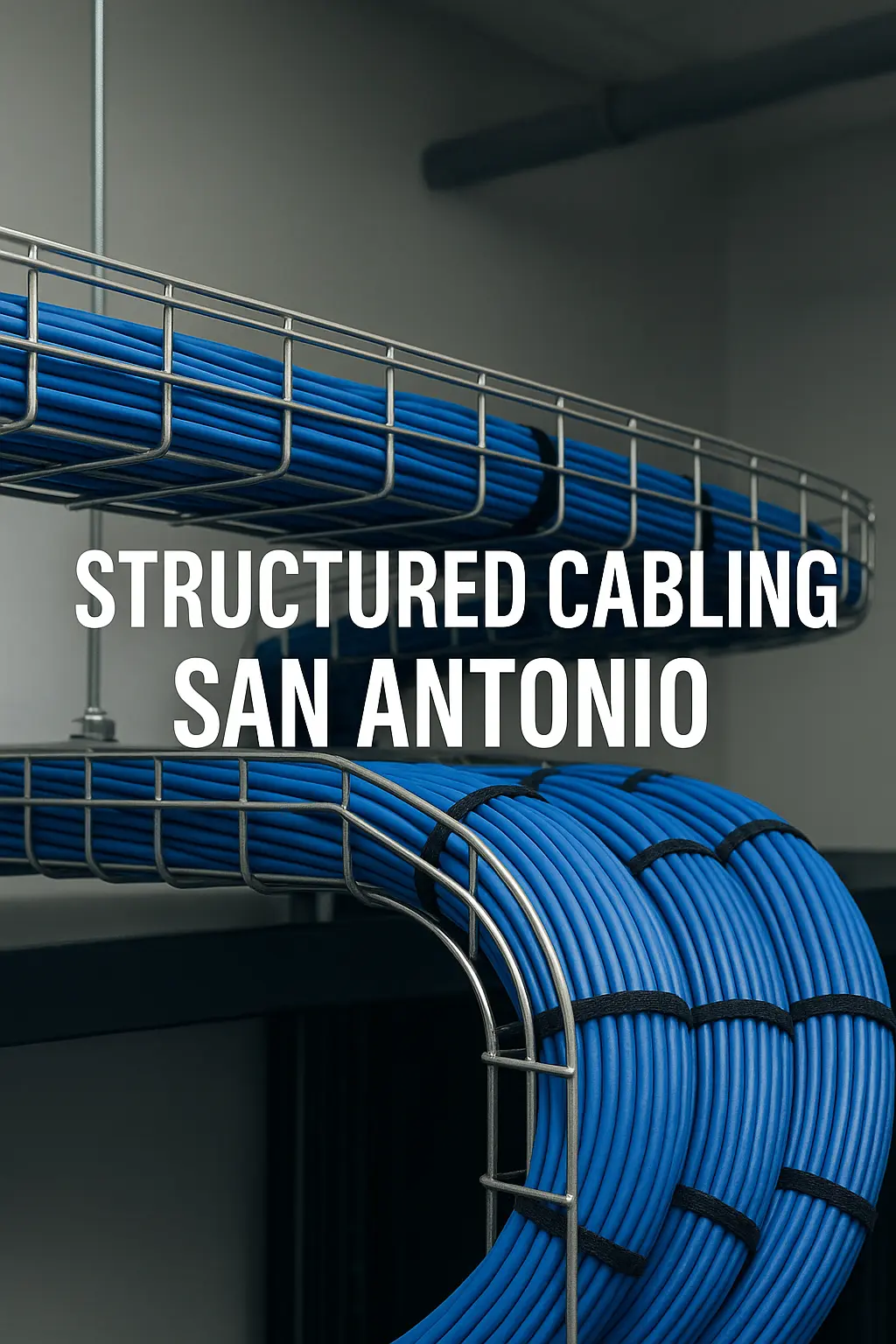Structured Cabling San Antonio
Design • Installation • Certification — Cat6/Cat6A & Fiber for reliable, scalable business networks in the San Antonio area.
- Cat6/Cat6A horizontal runs with neat termination and labeling
- Fiber backbone design and termination (SM/MM)
- Wi-Fi backhaul and PoE readiness (cameras, phones, APs, sensors)
- Complete documentation: maps, port schedules, test results
- After-hours cutovers to minimize disruption
Whether you’re opening a new location, remodeling, or standardizing multiple sites, our San Antonio structured cabling team can survey, scope, and deliver a standards-compliant installation on deadline.
Network Cabling Services
Every project is engineered around your space, applications, and growth plan. We follow BICSI best practices and manufacturer specs to ensure performance, longevity, and ease of maintenance.
New Buildouts & Remodels
From core/server room to the last workstation, we design cable routes, choose pathways and containment, and coordinate with electricians and GCs to stay on schedule. We install ladder racks, patch panels, managers, and perform complete rack dressing for a professional finish.
Cat6 / Cat6A Horizontal Cabling
We terminate on keystones or patch panels, label both ends, and certify each drop. Cat6A gives you headroom for multi-gig and dense PoE devices; we’ll help you decide the right category by distance, density, and interference factors.
Fiber Backbone & Termination
Single-mode or multi-mode fiber backbones connect IDFs to your MDF with low-loss terminations and test documentation. We also install splice trays, enclosures, and patching for future growth.
Wi-Fi & PoE Device Cabling
Access points, VoIP phones, cameras, door controllers, and sensors all rely on a healthy cabling plant. We plan AP grid locations, ensure proper PoE budgets, and label device drops for fast service later.
Moves, Adds & Changes (MAC)
Need to reconfigure a department or add new workstations? We handle small MAC tickets through phased work with minimal downtime.
Testing & Certification
Each run is tested with calibrated gear (OLTS/OTDR for fiber, certification testers for copper). You receive PDFs with results, labeled floor plans, and a port map that speeds future troubleshooting.
Cable Installation Process
- Discovery & Site Survey: We document floor plans, switching locations, cable routes, wall types/ceilings, and any special requirements (security, cooling, fire stops).
- Design & Scope: We propose cable categories, fiber types, pathways, patching standards, rack elevations, and labeling conventions.
- Build & Termination: Cables are pulled, dressed, and terminated to spec; trays and managers keep bundles clean and serviceable.
- Testing & Documentation: We certify every drop/backbone and deliver results with as-built diagrams and port schedules.
- Cutover & Handover: We coordinate the go-live (after-hours when needed), validate endpoints, and provide a maintenance checklist.
This structured approach produces a cabling system that’s reliable on day one and easy to manage for years.
Structured Cabling Benefits
- Performance: Proper bend radius, separation, and termination minimize errors and maximize throughput.
- Scalability: Patch field planning and labeling simplify expansions and device rollouts.
- Uptime: Clean racks and documentation cut mean-time-to-repair.
- Compliance: Installations follow BICSI/ANSI/TIA standards and manufacturer specs.
- Clarity: You get complete documentation for onboarding new IT staff or vendors.
Installation Cases per Industries
We’ve planned and installed structured cabling for organizations across the region, including:
- Professional offices and co-working spaces
- Healthcare and dental clinics
- Distribution centers and light industrial
- Retail and hospitality
- Education and municipal facilities
Pricing & Scheduling
Every building is different. Pricing depends on drop count, ceiling type, pathways, distance, and after-hours needs. Tell us your timeline and device count; we’ll provide a clear scope with materials, labor, and documentation included—no surprises.
Structured Cabling FAQ
What’s the difference between Cat6 and Cat6A?
Cat6 supports 1 Gbps at 100 m and can reach 10 Gbps at shorter runs; Cat6A is designed for 10 Gbps up to 100 m with better noise rejection. Cat6A is great for dense PoE and Wi-Fi backhaul.
Do you label and test every drop?
Yes. Each copper run is certified to spec and labeled at both ends; fiber links include OLTS/OTDR results. You receive PDFs and an as-built port map.
Can you work after hours?
We routinely schedule evening or weekend cutovers to avoid downtime.
Do you install fiber backbones?
Yes—single-mode and multi-mode with low-loss connectors, trays, and enclosures, documented with test results.
Can you integrate with security cameras, VoIP, or access control?
Absolutely. We coordinate with your camera, phone, and access vendors and make sure the cabling plant supports PoE power budgets and placement.
How fast can we start?
For small offices, we can often survey within a few days and start soon after materials are on site. Larger projects are phased and coordinated with your GC or landlord.
Network Installation Service Area
San Antonio and nearby communities including New Braunfels, Schertz, Universal City, Live Oak, Selma, Boerne, Helotes, Seguin, and San Marcos.
Get a Quote for Structured Cabling
Share your floor plan, device count, and timeline. We’ll scope your structured cabling project and provide a clear proposal with installation dates and documentation deliverables.
or
Back to top
